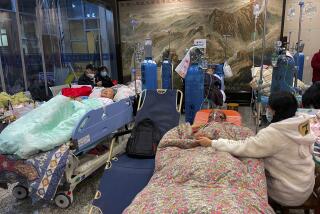Bird flu deaths among Chinese reach 6
BEIJING -- A new form of bird flu has infected more than a dozen people and caused six deaths in China in the last two months, according to official Chinese media reports.
As of Friday, Chinese media reported 14 people were infected with the virus, a bird-borne strain of influenza known as H7N9. Six of the 14 patients lived in Shanghai, with the remaining patients from nearby provinces. Most patients reportedly worked in direct contact with birds in the poultry industry.
No cases of human-to-human transmission of the virus have been reported.
Lu Hongzhou, a professor at Shanghai Public Health Clinical Center, told Chinese media in an interview Friday that H7N9 is not especially harmful among birds hosting the disease, but is more dangerous for humans, who have no resistance to the virus.
Shanghai’s city government announced Friday that all live poultry markets in the city would be closed as of Saturday. No reopening date has been announced.
Animal-based disease outbreaks are a serious public concern in China, where several viruses have become contagious among humans and caused epidemics in the last decade. According to data from the World Health Organization, the avian-borne virus H5N1 has caused 30 deaths in mainland China since 2003. SARS, a virus linked to civet cats, caused an estimated 349 deaths in mainland China and 299 in Hong Kong between 2002 and 2003.
The World Health Organization also reported in 2003 that efforts to research and respond to the SARS outbreak in China had been slowed by officials attempting to cover up the details of the outbreak.
Central Chinese authorities made an initial notification of three H7N9 cases to the WHO on Sunday. The notification stated that the patients had caught the virus between Feb. 19 and March 15, and that the infection led to death in two cases.
A hospital worker in the central Chinese city of Nanjing on Tuesday published online an image of another H7N9 diagnosis dated March 30, not included in the official report to the WHO. The original post was deleted by censors, but the disclosure was followed the next day by an official media report disclosing more confirmed H7N9 cases.
Zhan Jiang, a professor of journalism at Beijing Foreign Studies University, said that thanks to new regulations, it would be more difficult for local officials to conceal an outbreak of disease than it was a decade ago.
“Nowadays, there are new regulations and laws about emergency health issues as well as guidelines on how and when to disclose,” said Zhan. “There are lessons that have learned from SARS; it is not possible for them to hide cases like before.”
ALSO:
Prime Minister Cameron argues to keep Britain’s nuclear arsenal
Many South Koreans seem blase about threats from North Korea
North Korea belligerence looms ominously over Iran nuclear talks
Times staff writer Barbara Demick contributed to this report.
More to Read
Sign up for Essential California
The most important California stories and recommendations in your inbox every morning.
You may occasionally receive promotional content from the Los Angeles Times.










